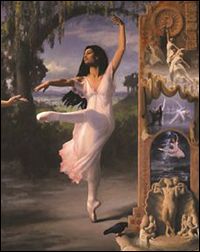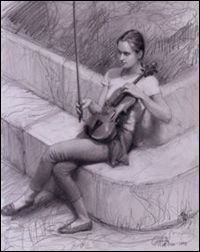 |
 |
Cover Paintings by
Matthew Joseph Peak
|
|

|
 |
Interview
?:
What was your first artwork for Varèse Sarabande and why do you think they chose you?
Matthew Joseph Peak:
Screen Themes and Miklós Rózsa: Hollywood Legend were my first two covers for Varèse.
Robert Townson's reaction to my art for the poster A Nightmare On Elm Street, Part 4 was what
caused him look into finding out who the artist was. I have always signed my paintings "Matthew" so
he actually had no idea that I was a "Peak". Robert is a huge fan of my father's and had previously
commissioned a painting of Jerry Goldsmith from him for a CD called Suites and Themes. Robert also
licensed a couple of my dad's gallery paintings for two early Bernard Herrmann CDs. When he finally
tracked me down and made the connection that I was actually Bob Peak's son it was a very nice surprise.
That was over forty CDs ago now! I think for the early CDs Robert was trying to capture a genuine "film"
feel in the artwork but with a twist, so to speak. It wasn't long before we started directing the
artwork for the CDs, particularly for the recordings of the classics, into the world of fine art.
I think this is particularly evident with CDs like Fahrenheit 451, Blood & Thunder and
2001, among others. For these paintings the conceptual seed may have come from a film but
otherwise the painting really went off in its own direction. These are the pieces I find most rewarding to work on.
?:
You seem to have specialized in Bernard Herrmann cover art. What attracts you about Herrmann?
MP:
I don't specialize in Herrmann but I am an integral element of the Varèse recording series. Robert Townson has certainly made recording Herrmann a priority so this has lead to Joel McNeely conducting a lot of Bernard Herrmann and to me doing a lot of paintings inspired by Bernard Herrmann. I love the richness and dreamy moods he gets. I am a romantic at heart and I find his love themes very moving. The unique arrangements, the layering and the instrument combinations are all done in such a way that only Herrmann could. I like tracing things down to their archetype origins and with a lot of scores I find that they distill down to a good dose of Bernard at their core.
?:
What are your main influences when starting on a new project, the film or the music?
MP:
Both. I tend to lean toward the music, but neither can be ignored. It needs to be obvious what the movie is so there is no
confusion, but once you're past that the feel and mood step to the forefront. In many cases these are re-recordings
of the score so it should have a different flavor than the original soundtrack (if available). With classic scores/films
the movie is well known so creating a unique and fresh visual is crucial. The challenge of Citizen Kane
was to somehow capture or perhaps convey might be a better word, the film without falling back on cliché and
without, in any way, becoming trite. A recording of Bernard Herrmann's Citizen Kane with the
Royal Scottish National Orchestra does not have to worry about being "hip" or "commercial." In fact either of
these thing would seriously undermine the seriousness with which we treat these projects.
At the same time, there is a wealth of very famous imagery from this film and it also wouldn't be
right to turn my back on this. Citizen Kane, then, became one of the few CDs I have worked on where I felt the
packaging really needed to be considered as a whole. A single painting for the cover just wouldn't be enough.
It was actually for The 7th Voyage of Sinbad where I first did two paintings for one CD.
Ultimately I created four pieces of art for the Kane release: the deep focus Xanadu interior with Susan on
the floor in the foreground doing her puzzle and Kane in silhouette looking on from way in the background. This was
for the front cover; a very dark, moody and lonely piece. It was also a fun opportunity to include the sculpture
Venus by Canova, which is one of my favorites. For the back inlay card I did a pastel of the Xanadu exterior and
a small watercolor of Kane's speech. For the inside of the booklet I did a pencil sketch of the Inquirer newspaper masthead.
?:
When did you first see Kane?
MP:
I first saw the picture when I was a kid. My dad would get home from his studio late at night and we would watch the
midnight movie together. My first exposure to a lot of classic films came this way.
?:
Do you think the artwork is a deciding buying factor to the casual buyer?
MP:
Yes, the dedicated fan will buy regardless of what the cover looks like, but the rest need the artwork to bring
them in as well as to remind them. It's an interesting thing to look at or consider and it probably varies
from one consumer to the next. What is it that makes you pick up a CD in a store? Does it make a difference to
you if you are ordering something on-line if you don't get to see a picture of the disc? What are the other
elements that kick in to make you actually purchase the disc? There are all of these elements... the composer, the movie,
who's performing the music, what label it's on, the track record of everyone involved with the recording and the
packaging. I know that the look of a CD is extremely important to Robert Townson. So much so that he contacts me
about a project often before it is even recorded, sometime a year in advance. I've been booked to
do Citizen Kane for, I think, about two years now. Since I have other gallery commitments and
commissions to schedule as well which can fill months at a time it's important to plan ahead.
?:
Your father, Bob Peak, is a prominent figure in the world of movie poster art. Do you think this has influenced your style?
MP:
My late father has had a tremendous influence on me ever since I was a little kid. Seeing my dad's work was what got me interested in art and in being an artist. I actually apprenticed with him even before I decided on pursuing it as a career myself. Once my own path had been established I found it even that much more rewarding and inspiring to talk to my dad about art. Today I think it's sad that the whole concept of an "artistic community" where artists get together to talk about their work has been lost to history. The value of having someone at that level share their experiences with you is incalculable. His work ethic, his drive and everything he achieved made an enormous impression on me. Stylistically I think my work was much more directly affected by him when I was younger. You can see it in my early paintings. As time has gone on I think I have developed a much more distinct and individual voice apart from my father's. There is still a connection there but it is much more abstract and less tangible.
?:
What other artists influenced you most?
MP:
DaVinci, Michelangelo, Waterhouse, Inness, Alma Tedema, Monet, etc. For the most part it was the masters as opposed to current artists with the exception of my father and Roger Dean.
?:
Do you have any upcoming projects you'd like to tell us about?
MP:
More paintings!! I am represented by a gallery in San Francisco, Christopher Clark Fine Art, so I am in the midst of
many new works. I just dove into the digital world with Themes from The Phantom Menace and Other Film Hits.
It will be interesting to see what comes from this new medium. I just finished two paintings (Eye of the Beholder and The Lonely)
for the new recording of Herrmann's The Twilight Zone. For next year I know I will be on the Peyton Place project and,
I understand, my next Herrmann outing will be Marnie.
?:
When will your Herrmann artwork be available as posters?
MP:
I hope that one day all of my CD cover art will be available as posters, but right now they are not. It would be great to hear from people who would like to be notified if prints or posters become available. It would also be interesting to hear which paintings people are most interested in.


Copyright © 1999 by The Bernard Herrmann Society.
All rights reserved.
|
|
 |
|
 |
|
|
|
|
|
|
|
www.bernardherrmann.org / The Bernard Herrmann Society
International Society for the Appreciation of the Music of Bernard Herrmann (1911-1975)
|
|
|
|